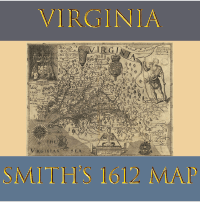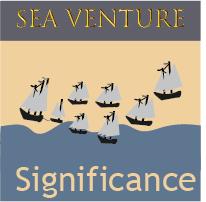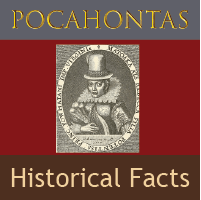Roanoke Dare Stone
The Roanoke Dare Stone claims to be written by Eleanor Dare in 1581.
What does it say, where was it found, and is it authentic?
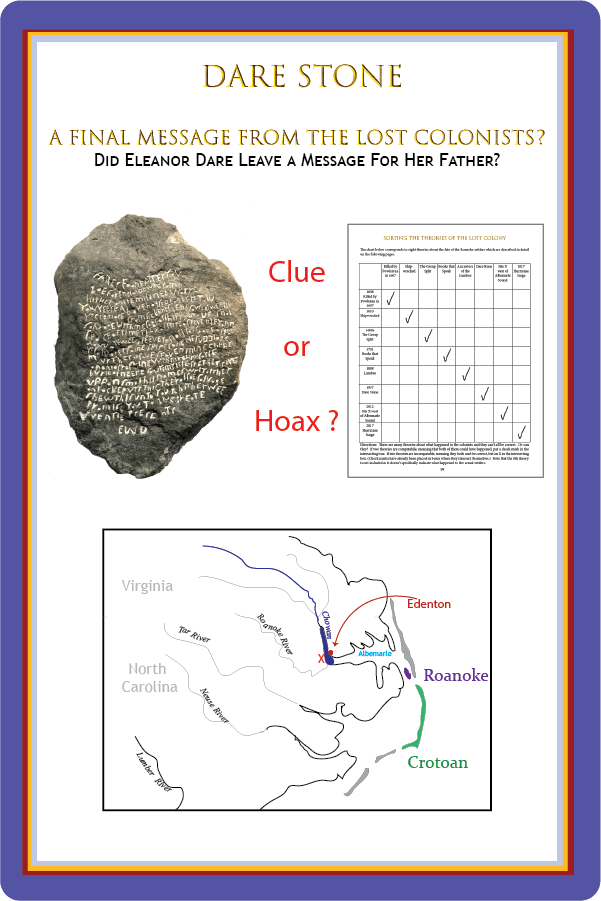
History of the Dare Stone
In 1937 a man named Louis Hammond found a 21 pound stone near Edenton, North Carolina that seemed to be a message from Eleanor Dare to her father, Governor John White. Also called the Chowan River Stone, it told how the settlers suffered miserably, moved inland, and all but seven were dead.Hammond took the stone to Emory University in North Carolina, and Professor Hayward Pearce took interest in the stone and it's possible authenticty. After news of the stone was published in the Journal of Southern History in May 1938, the nation was transfixed by the story it contained.
However, the stone was found not long before North Carolina celebrated the three-hundred and fiftieth year of the Roanoke Settlement (1587 to 1937.)
Publicity Stunt?
OR
Authentic Evidence?
What Does the Eleanor Dare Stone Say?
Front of the Stone
Carved into the front of the stone are these words:
Ananias Dare & Virginia went hence vnto heaven 1591
Anye Englishman shew John White Govr Via
Message on the Back of the Eleanor Dare Stone
Transcribed into modern English, the one paragraph, choppy message reads:Father, soon after you went for England we came here. Only misery and war for two years. More than half died these two years, more from sickness, about twenty-four. A savage with a message of a ship came to us but in a short time they were afraid of revenge and all ran away. We did not believe it was you. Soon after savages said the spirits were angry and suddenly murdered all except seven. My child and Ananias were slain. Much misery. All buried near four miles east of this river upon a small hill. All names written on the rock there. Put this there also. If any savages show this to you we promised you would give great presents. EWD
The actual message in Elizabethean English reads:
FATHER SOONE AFTER YOV
GOE FOR ENGLANDE WEE CAM
HITHER ONLIE MISARIE & WARRE
TOW YEERE ABOVE HALFE DEADE ERE TOW
YEERE MORE FROM SICKNES BEINE FOVRE & TWENTIE
SALVAGE WITH MESSAGE OF SHIPP VNTO US SMAL
SPACE OF TIME THEY AFFRITE OF REVENGE RANN
AL AWAYE WEE BLEEVE YT NOTT YOV SOONE AFTER
YE SALVAGES FAINE SPIRTS ANGRIE SVDDIANE
MVRTHER AL SAVE SEAVEN MINE CHILDE
ANANIAS TO SLAINE WTH MVCH MISARIE
BVRIE AL NEERE FOVRE MYLES EASTE THIS RIVER
VPPON SMAL HILL NAMES WRIT AL THER
ON ROCKE PVTT THIS THEIR ALSOE SALVAGE
SHEW THIS VNTO YOV & HITHER WEE
PROMISE YOV TO GIVE GREATE
PLENTIE PRESENTS
EWD
A Great Hoax?
The public was interested in this story, and over the next several years more than 40 other stones were found. All of them but the original have been proven to be a hoax. Professor Hayward had offered money for additional stones, and not surprisingly more stones were found. Hayward's professional reputation was badly damaged by the hoax.But the original Chowan River Stone was different from the others. Could it be real? Because of the embarrassment of the hoax, some researchers did not want to investigate the first stone. It had been a career-smashing hoax for Hayward and no other historian wanted to suffer the same fate.
In this century some have examined the original Dare Stone and believed the carved message is several hundred years old. Not every one agrees. But some language experts have found the writing to be more authentic to Elizabethean English than would be expected from a fraud.
Evidence for and Against the Stone

- The other Chowan River stones are known to be hoaxes.
- The original stone is different in size, lettering, and other features.
- Louis Hammond disappeared and no evidence of anyone by this name has been found.
- All of this happened the year before North Carolina promoted the 350th anniversary of the Lost Colony.
- More recently, evidence turned up on an old map of John White's that the colonists had been interested in the Chowan River area. No one in 1937 had evidence of this.
- Some Elizabethean language experts say there are peculiar phrases on the stone that a con-man would not know.
- Some point out that EWD's instructions to a native to take the stone to her father don't really make sense. This has been argued for and against its authenticity.
- Spanish sailors reported that natives were intested in their ships, somewhat like the Dare stone indicated. These reports only recently surfaced in English.
Dare Stone vs Other Lost Colony Theories
Students compare and contrast the different theories. Is the Dare Stone compatible with these other theories?- The Roanoke Colonists were killed by Powhatan about 20 years later.
- The colonists attempted to sail away and were shipwrecked.
- They mixed with local native tribes.
- They migrated to Site X on the Chowan River.
- The colony was destroyed by a hurricane.
Early Engish Settlements
Learn more about Roanoke, Jamestown, Bermuda, and Popham Settlements in our Early Settlements Unit Study. Information, maps, and activities in this multi-level unit study engage learners in an active exploration of the first attempts of English colonization that shaped the nation.Get the Early Settlers Unit Study

Available in Paperback OR Printable Download
199 pages (Includes Student Pages, Teacher Key, Schedule, Maps, Activities, and More)
Print It Now



Student and Teacher's Material Included
$5.99 Download - 199 pages
![]()
Softcover Edition - Mailed to You
The same pages are in the softcover book and the printable file. Bound copy is great for repeat use or co-op leaders.

![]()
16.95 Soft Cover Manual
199 pages
Mailed to You
Early Settlers Pages
Check out our other pages for the Early Settlers Unit Study
Get the Lion To Guard Us Unit Study
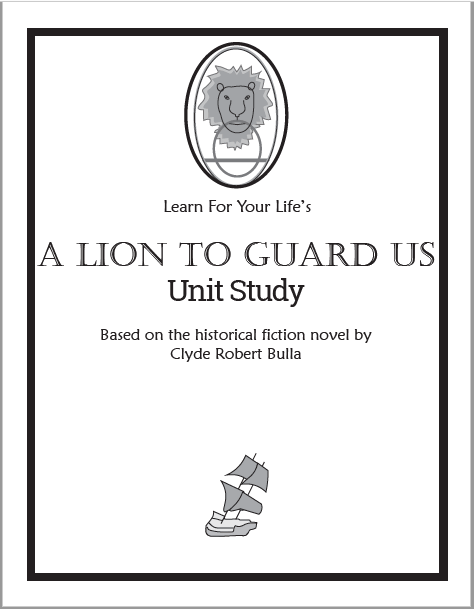


Student Guide AND Teacher's Answer Key Included
$2.99 Download - 78 pages
![]()
Our pages for A Lion To Guard Us
Clyde Bulla's Historical Fiction of Jamestown & the Sea Venture


About Our Site
Hands-On Learning









